Scin 140 - Study guides, Class notes & Summaries
Looking for the best study guides, study notes and summaries about Scin 140? On this page you'll find 22 study documents about Scin 140.
All 22 results
Sort by
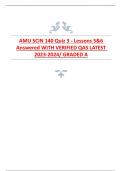
-
AMU SCIN 140 Quiz 3 - Lessons 5&6 Answered
- Exam (elaborations) • 8 pages • 2023
-
- $14.99
- + learn more
Part 1 of 1 - 100.0/ 100.0 Points Question 1 of 10 10.0/ 10.0 Points Which of the following mining processes removes the top layers of soil, rock, and vegetation to access minerals? A. Acid mine drainage B. Subsurface mining C. Smelting D. Surface mining Answer Key: D ...
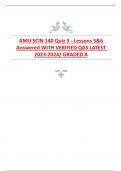
-
AMU SCIN 140 Quiz 3 - Lessons 5&6 Answered
- Exam (elaborations) • 8 pages • 2023
-
- $14.99
- + learn more
Part 1 of 1 - 100.0/ 100.0 Points Question 1 of 10 10.0/ 10.0 Points Which of the following mining processes removes the top layers of soil, rock, and vegetation to access minerals? A. Acid mine drainage B. Subsurface mining C. Smelting D. Surface mining Answer Key: D ...
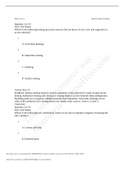
-
AMU SCIN 140 Quiz 3 - Lessons 5&6 Answered
- Exam (elaborations) • 7 pages • 2021
-
- $8.39
- 3x sold
- + learn more
Part 1 of 1 - 100.0/ 100.0 Points Question 1 of 10 10.0/ 10.0 Points Which of the following mining processes removes the top layers of soil, rock, and vegetation to access minerals? A. Acid mine drainage B. Subsurface mining C. Smelting D. Surface mining Answer Key: D Feedback: Surface mining removes surface vegetation, rocks, and soil to create an open pit for mining. Subsurface mining uses vertical or sloping shafts to access minerals deep underground. Smelting ...
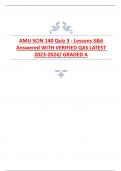
-
AMU SCIN 140 Quiz 3 - Lessons 5&6 Answered
- Exam (elaborations) • 8 pages • 2023
-
- $9.69
- + learn more
Part 1 of 1 - 100.0/ 100.0 Points Question 1 of 10 10.0/ 10.0 Points Which of the following mining processes removes the top layers of soil, rock, and vegetation to access minerals? A. Acid mine drainage B. Subsurface mining C. Smelting D. Surface mining Answer Key: D ...
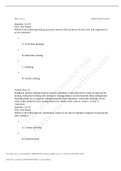
-
SCIN 140 Quiz 3 - Lessons 5&6 Answered 2021/SCIN 140 Quiz 3 - Lessons 5&6 Answered 2021
- Exam (elaborations) • 7 pages • 2021
-
- $8.99
- 1x sold
- + learn more
AMU SCIN 140 Quiz 3 - Lessons 5&6 Answered 2021 Return to Assessment List Part 1 of 1 - 80.0/ 100.0 Points Question 1 of 10 10.0 / 10.0 Points Which of the following mining processes removes the top layers of soil, rock, and vegetation to access minerals? • A. Acid mine drainage • B. Subsurface mining • C. Smelting • D. Surface mining Question 2 of 10 10.0 / 10.0 Points Which of the following soil conservation issues occurs due to improper irrigation increasing the soil’s salinity? •...
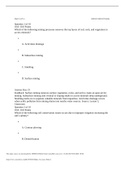
-
Quiz 3 - Lessons 5&6.docx 100% verified
- Exam (elaborations) • 7 pages • 2022
-
- $10.49
- + learn more
Which of the following mining processes removes the top layers of soil, rock, and vegetation to access minerals? A. Acid mine drainage B. Subsurface mining C. Smelting D. Surface mining Answer Key: D Feedback: Surface mining removes surface vegetation, rocks, and soil to create an open pit for mining. Subsurface mining uses vertical or sloping shafts to access minerals deep underground. Smelting melts ore to separate valuable minerals from impurities. Acid mine drain...
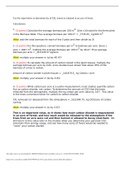
-
Week_5_Trees_and_Carbon_Activity_Sheet_Revised.docx
- Exam (elaborations) • 5 pages • 2022
-
- $10.49
- + learn more
1. (5 points) Calculate the average biomass per 100 m2 (10m x 10m plot) for the three plots in the Biomass Table. Thus average biomass per 100 m2 = _7735.25_ kg/100 m2 (Hint: add the total biomass for each of the 3 plots and then divide by 3) 2. (5 points) For this question, convert biomass per m2 to biomass per acre. Since 1 acre = 4047 m2 , multiply the average biomass per 100 m2 by 40.47. Thus average biomass per acre = _313,045.57 kg/acre (Hint: multiply your answer in (a) by 40...
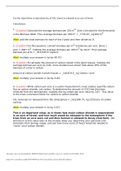
-
Week_5_Trees_and_Carbon_Activity_Sheet_Revised.docx
- Exam (elaborations) • 5 pages • 2022
-
- $10.89
- + learn more
Use the steps below to determine the of CO2 stored or released in an acre of forest. Calculations: 1. (5 points) Calculate the average biomass per 100 m2 (10m x 10m plot) for the three plots in the Biomass Table. Thus average biomass per 100 m2 = _7735.25_ kg/100 m2 (Hint: add the total biomass for each of the 3 plots and then divide by 3) 2. (5 points) For this question, convert biomass per m2 to biomass per acre. Since 1 acre = 4047 m2 , multiply the average biomass per 100 m2 by ...
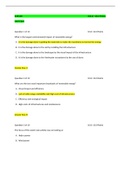
-
American Military University SCIN 140 LAB 8 Quiz (solved) | SCIN140 Lab 8-Quiz 100.0/ 100.0 Points
- Exam (elaborations) • 4 pages • 2021
-
- $5.99
- 1x sold
- + learn more
SCIN140 100.0/ 100.0 Points Lab 8 Quiz Question 1 of 10 What is the largest environmental impact of renewable energy? A. It is the damage done in getting the materials to make the machinery to harvest the energy B. It is the damage done to the soil by installing the infrastructure C. It is the damage done to the landscape by the visual impact of the infrastructure D. It is the damage done to the freshwater ecosystems by the use of dams Question 2 of 10 ...
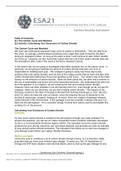
-
Week_6_Personal_Impact_Analysis_Carbon_Revised
- Case • 4 pages • 2022
-
- $9.99
- + learn more
Table of Contents: (1.) The Carbon Cycle and Mankind (2.) Activity: Calculating Your Emissions of Carbon Dioxide The Carbon Cycle and Mankind We have seen that plants sequester large sums of carbon in themselves. They are able to do this since, on average, photosynthesis produces more sugar than what is need by the plant during its respiration phase. As long as the plant is alive, it will continue to take carbon dioxide out of the air. However, we also found that a plant will return all o...

How did he do that? By selling his study resources on Stuvia. Try it yourself! Discover all about earning on Stuvia


